 sponsored by
sponsored by

By SCOTT FYBUSH
It's hard to believe that this is the thirteenth time we've
sat down at year's end to try to make sense of another twelve
months' worth of sales, format changes, studio moves, firings,
hirings, deaths, tower collapses, NIMBY fights and all the other
things we track across the northeastern US and eastern Canada.
It's even harder, in some ways, to believe that this is still
the same industry it was when we perched in front of the keyboard
in 1995 for the first "NERW Year in Review."
More on that later on in the Year in Review, as we get to
the "Year-End Rant." First, our annual top-10 list
of the people and events who made headlines in the region this
year.
1. The I-Man, His Foot, His Mouth, Rev.
Sharpton and Citadel
It's a pretty good bet that when Don Imus and his producer
Bernard McGuirk were bantering about the Rutgers University women's
basketball team on the morning of April 4, neither of them had
any clue that they were about to touch off a controversy that
would take "Imus in the Morning" off the air and consume
much of the nation's attention for the next several weeks.
 At first, CBS Radio
(owner of Imus flagship WFAN and of the syndicated show itself)
stuck by its lucrative host, as did his TV home, MSNBC, but within
a week the tide had turned against Imus, with MSNBC first to
suspend him, followed the next day by WFAN, with a day yet to
run in the show's annual radiothon. At first, CBS Radio
(owner of Imus flagship WFAN and of the syndicated show itself)
stuck by its lucrative host, as did his TV home, MSNBC, but within
a week the tide had turned against Imus, with MSNBC first to
suspend him, followed the next day by WFAN, with a day yet to
run in the show's annual radiothon.
After a meeting with the basketball team, Imus kept a low
profile the rest of the year, taking legal action against CBS
but making no public comment. In the meantime, both WFAN and
MSNBC scrambled to find replacements, with the TV network eventually
settling on its own Joe Scarborough and WFAN spending the summer
with a series of fill-ins before hiring Craig Carton (from New
Jersey 101.5) and "Boomer" Esiason in September.
By then, Imus and CBS had settled their contract dispute,
and Imus' agents were in negotiations to bring him back to the
air elsewhere. After weeks of rumors, Citadel's WABC and the
RFD-TV network announced deals with Imus early in November, with
WABC cancelling the hugely successful "Curtis and Kuby"
morning show, and on December 3 Imus returned to the airwaves
with a newly diverse cast of sidekicks, a lengthy apology for
his April comments, and an affiliate list that included some
of his old stalwarts (such as WTKK in Boston, about which more
in a moment) but was missing other former Imus markets, including
Philadelphia and most of northern New England.
2. Mr. Carr, His Agent, and Boston's Talk
Rivalry
While Don Imus' mouth was getting him in trouble in New York,
one of Boston's most prominent talkers was silenced for much
of the year for another reason: a contract dispute.
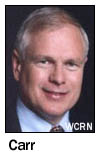 On July 9, Howie
Carr's lawyers announced that the veteran WRKO (680) afternoon
host would be leaving the Entercom talk station for greener pastures,
moving to the morning slot at Greater Media's WTKK (96.9) that
just happened to have been recently vacated by Don Imus. Carr's
contract with WRKO was set to expire in September, and Entercom
had failed to exercise a renewal clause - until Carr threatened
to jump. On July 9, Howie
Carr's lawyers announced that the veteran WRKO (680) afternoon
host would be leaving the Entercom talk station for greener pastures,
moving to the morning slot at Greater Media's WTKK (96.9) that
just happened to have been recently vacated by Don Imus. Carr's
contract with WRKO was set to expire in September, and Entercom
had failed to exercise a renewal clause - until Carr threatened
to jump.
The result was a legal soap opera that filled Boston radio
headlines for most of the rest of the year, as Carr first returned
to the air at WRKO, then vanished again while enduring a series
of legal rulings that came down pretty consistently in Entercom's
favor. By mid-November, Carr effectively conceded defeat, signing
a new contract with Entercom that returned him to the air at
WRKO until at least 2012. (It didn't help Carr's case that WTKK
suddenly had an easy solution to its own morning woes, as the
revived Imus show became available to return to its old Boston
home.)
The return to status quo for both Carr and Imus still left
other holes in Boston's talk picture, most notably in morning
drive at WRKO, where former House speaker Tom Finneran struggled
to find success as a talk host. WRKO's midday lineup was shuffled
as well, with Todd Feinburg giving way to Reese Hopkins at year's
end. Over at WTKK, Mike Barnicle spent some time filling the
former Imus slot, then left his old mid-morning slot vacant as
he left the station to concentrate on his columns and TV commentary
(though he did return with a daily commentary during Imus' show),
while Herald reporter Michele McPhee moved from frequent
fill-in host to full-time evening talk host, leaving the paper
in November to focus on her new radio career.
3. WCBS-FM roars back, while "Free"
fades from the picture
A big management change at the head of CBS Radio - the ouster
of Joel Hollander and the return of Dan Mason - brought big changes
to some of the group's largest stations in 2007, particularly
at the company's New York FM signals. While the long-suffering
102.7 had finally found some stability at the start of the year
with its new "Fresh" AC identity, WFNY-FM (92.3 Free
FM) was suffering from the post-Imus fear of controversy that
gripped much of talk radio - and WCBS-FM (101.1) was just plain
suffering in its jockless "Jack FM" format, with billings
far off the mark it had set in its previous oldies format.
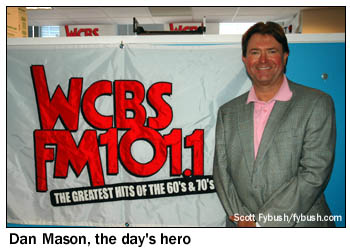 It didn't take long
for Mason to make some big changes. In late May, "Free FM"
was history and "K-Rock" WXRK was back in place at
92.3, albeit without Howard Stern, whose show had drawn most
of the old K-Rock's revenues. And then, in the course of just
a few days in July, the return of oldies to WCBS-FM exploded
from message-board fantasy to rumor to reality, with TV crews
(and NERW!) on hand as Bob Shannon cued up the Beach Boys and
oldies (er, "classic hits") radio returned to the New
York airwaves. It didn't take long
for Mason to make some big changes. In late May, "Free FM"
was history and "K-Rock" WXRK was back in place at
92.3, albeit without Howard Stern, whose show had drawn most
of the old K-Rock's revenues. And then, in the course of just
a few days in July, the return of oldies to WCBS-FM exploded
from message-board fantasy to rumor to reality, with TV crews
(and NERW!) on hand as Bob Shannon cued up the Beach Boys and
oldies (er, "classic hits") radio returned to the New
York airwaves.
Mason cleaned up some messes in other markets, too, restoring
rocker WYSP (94.1) after a year of "Free FM" in Philadelphia
and bringing top-40 "B94" back to Pittsburgh (replacing
"Man Talk" WTZN-FM 93.7) after a longer absence there.
4. Station sales slow to a crawl...
A decade after the consolidation binge found thousands of
stations changing hands, there wasn't much new money entering
the broadcast scene in the northeast (or elsewhere) in 2007.
Most of the big headlines came from private equity looking to
pick up stations at a (relative) bargain price in hopes of cutting
costs even further, and even there the going was slow. At year's
end, deals that would have taken Clear Channel private - and
that would have spun off its TV group and many of its smaller
clusters to other private buyers - had yet to close.
For the few existing owners with available cash, there were
good signals to be had at reasonable prices, as Galaxy found
with its Utica expansion and as California's EMF Broadcasting
found with its many acquisitions across the region to expand
its "K-Love" and "Air 1" networks.
5. ...except in Canada, where it's still
merger-mania time
While station owners on the US side of the border hunkered
down and waited for better economic times, a series of huge deals
north of the border reshaped the media landscape there in a consolidation
frenzy that put some of the biggest US deals of recent years
to shame (at least when adjusted for the smaller overall size
of the Canadian media marketplace.)
 The largest of all
was the C$1.7 billion takeover of CHUM Limited by CTVglobemedia,
which saw the Waters family exit broadcasting after more than
half a century. Already a major player in TV (CTV, TSN) and newspapers
(The Globe and Mail), the CHUM acquisition gave CTV one
of the country's biggest radio groups, a second network of TV
stations (A Channel), and a big portfolio of cable channels including
MuchMusic, Bravo! Canada and Space. (CHUM's CityTV group, in
turn, was spun off to Rogers, increasing that media giant's TV
footprint substantially.) The largest of all
was the C$1.7 billion takeover of CHUM Limited by CTVglobemedia,
which saw the Waters family exit broadcasting after more than
half a century. Already a major player in TV (CTV, TSN) and newspapers
(The Globe and Mail), the CHUM acquisition gave CTV one
of the country's biggest radio groups, a second network of TV
stations (A Channel), and a big portfolio of cable channels including
MuchMusic, Bravo! Canada and Space. (CHUM's CityTV group, in
turn, was spun off to Rogers, increasing that media giant's TV
footprint substantially.)
Right behind the CHUM/CTV deal was the C$1.3 billion purchase
of Standard Radio by Astral Media, which immediately turned the
regional radio player in Quebec and the Maritimes into a major
national force by bringing stations such as Toronto's CFRB/CKFM/CJEZ
and Montreal's CJAD/CJFM/CHOM under the Astral banner.
6. The Great PPM Adventure
We didn't spend much time writing about Arbitron's Portable
People Meter (PPM) in the pages of NERW in 2007, largely because
the launch of the technology in Houston and then in Philadelphia
was amply and comprehensively covered in not only the national
trades, but in the mass media as well.
Even so, we can't let the year go by without a few paragraphs
about the little black pager-sized clip-on box that caused so
much controversy in the media community, in large part because
the numbers it returned showed far lower consumption of urban
and Hispanic formats, and far more listenership to mainstream
rock formats, than the old diary system recorded.
Was it the result of poor placement methodology, as some stations
claimed? Or was it a true reflection of listeners' habits? In
either case, the radio industry was quick to react in several
ways - first, by forcing Arbitron to postpone further rollout
of the PPM (including a planned replacement of diaries in New
York City with PPMs), and second, by shuffling formats. In Philadelphia,
FM talk on WYSP (94.1) and Spanish tropical "Rumba"
on WUBA (104.5) both vanished, replaced by rock - and by ratings
upticks on the PPMs.
Will the PPM rollout get back on track in 2008? Stay tuned...
7. Ice Storms and Downed Towers
 Mother Nature was
no friend to broadcasters in the region through much of 2007.
In April, "Mountain Lakes PBS" went dark across its
viewing area in New York, Vermont and Quebec when ice brought
down the tower of its WCFE-TV/DT on Lyon Mountain. Public-spirited
cooperation by other broadcasters, most notably Burlington's
WCAX (which arranged to put WCFE on one of its own WCAX-DT subchannels),
along with quick work by ERI and cooperative summer weather allowed
WCFE to get back on the air from a replacement tower by early
autumn. Mother Nature was
no friend to broadcasters in the region through much of 2007.
In April, "Mountain Lakes PBS" went dark across its
viewing area in New York, Vermont and Quebec when ice brought
down the tower of its WCFE-TV/DT on Lyon Mountain. Public-spirited
cooperation by other broadcasters, most notably Burlington's
WCAX (which arranged to put WCFE on one of its own WCAX-DT subchannels),
along with quick work by ERI and cooperative summer weather allowed
WCFE to get back on the air from a replacement tower by early
autumn.
The second major tower tragedy of 2007 came in December, when
the combination of ice and wind toppled the tower of Scranton's
WNEP (Channel 16), took off the top portion of the neighboring
WVIA-TV (Channel 44) tower, and threatened to collapse several
other towers on Penobscot Mountain. By the end of December, WNEP
had restored its analog signal at lower power from another nearby
tower that carries WNEP-DT, while WVIA restored its signals with
the use of a short auxiliary tower and the remaining portion
of its main tower. Thankfully, nobody was hurt in either collapse.
8. The HD radio fight comes to the AM dial
Just as 2005 and 2006 failed to be "the year" for
HD Radio to move from sideshow to mass medium, 2007 also brought
plenty of promise and little mainstream success.
On the plus side of the HD Radio ledger, the year brought
more FM HD signals to the airwaves, both in larger markets such
as Buffalo, Rochester and Syracuse and in smaller places like
Keene, New Hampshire, where the Saga cluster had converted all
its stations to HD by year's end. Receivers continued to drop
in price and improve in quality, with major brands such as Sony
joining the ranks, but availability at mass-market retailers
remained spotty at best, and consumer awareness remained relatively
low in most areas. (Public radio was a bright spot in the picture,
as several stations promoted FM HD multicasting to bring additional
programming to areas where it was in demand, including Vermont
Public Radio's launch of its classical service over an HD multicast
channel to much of the state.)
The year's biggest HD Radio headlines came with the summer
approval of full commercial operation for the system, allowing
FM stations to begin operating their multicast channels commercially
- and allowing AM stations to begin operating their HD signals
around the clock. Only a handful of AM stations in the region
were equipped with HD when fulltime operation became legal on
Sept. 14, and of those, not all were ready to run the system
at night.
Almost immediately, the interference complaints that had been
predicted by many DXers and at least some engineers came to the
fore. Some were the expected issues with HD sideband interference
to out-of-market skywave signals - Nashville's WSM (650) was
lost to hash from New York's WFAN (660) in many areas, for instance.
But there were also issues with skywave interference into protected,
in-market groundwave signals, including incursions from Detroit's
WJR (760) into New York's WABC (770) that were serious enough
to prompt Citadel, which owns both stations, to shut down nighttime
HD operation on its AM stations after just a few days.
Other interference issues were less easily resolved. CBS Radio's
WBZ (1030) caused problems well within the home market of sister
station KDKA (1020 Pittsburgh) - and within the home market of
Bob Savage's WYSL (1040 Avon NY). That small independent station
didn't take the incoming interference quietly: after a month
or so of measurements, Savage filed a formal complaint with the
FCC that had yet to be resolved at year's end.
9. Attack of the noncomms
With more than a decade having passed since the last FCC window
for new noncommercial FM station applications, broadcasters across
the region (and across the country) were primed for action when
the Commission finally cracked the window open again in October.
More than 3600 applications came in from around the country,
with applicants falling roughly into three groups: public broadcasters
hungry to expand their service areas or add additional services
in their existing territory, religious broadcasters (both national
and regional) looking to feed a growing appetite for their programming
and expand the reach of their networks, and local community groups,
schools and churches trying to stake out space on a dial that's
too full to accommodate everyone who'd like to broadcast.
The story of 2008, inevitably, will be the resolution of many
of those conflicts all across the region - and perhaps the addition
of new low-power FM services, as well, if the FCC is able to
make good on its promises to relax some of the technical restrictions
that have blocked would-be LPFM operators from the airwaves.
10. Tower down in the Meadowlands
 2006 didn't end especially
well for New York's WOR (710). It had pulled out all the publicity
stops for the September demolition of its 40-year-old tower site
in the New Jersey Meadowlands, complete with a party for clients
and live coverage from most of the city's TV stations, only to
have the demolition halted at the last minute by red tape and
missing paperwork. 2006 didn't end especially
well for New York's WOR (710). It had pulled out all the publicity
stops for the September demolition of its 40-year-old tower site
in the New Jersey Meadowlands, complete with a party for clients
and live coverage from most of the city's TV stations, only to
have the demolition halted at the last minute by red tape and
missing paperwork.
So there were plenty of nerves when it came time for another
try on January 11. This time, everything cooperated, including
the weather. Under a clear blue sky and unseasonably warm weather,
not to mention the watchful eye of two TV news helicopters, WOR's
second try came off perfectly. Guy wires on two of the towers
were cut simultaneously, sending those towers gracefully tumbling
to the ground. About eight minutes later, the tower crews made
it to the remaining tower, bringing it down as well to a round
of well-deserved applause and some big sighs of relief from station
management.
10A. The Nassau-WEEI deal collapses
We don't normally expect to be adding a big story to the site
on New Year's Eve afternoon - but when news breaks, we're here
with it. Had it gone through as planned, the deal between Nassau
and Entercom to expand the reach of Entercom's Boston-based WEEI
sports format would have been an interesting piece of programming
news, and not much more. The plan called for Nassau stations
in several Northern New England markets, as well as Cape Cod,
to begin carrying most of WEEI's programming - and for Entercom
to take a 50% interest in Nassau's classical WCRB (99.5 Lowell)
in the Boston market. Nassau had already started moving some
of its formats around to make room for the move (see "December"
in the programming section, below) - but now there's word that
Nassau and Entercom were unable to close the deal, and now the
arrangement is history. Will Entercom look to offer WEEI programming
to other, non-Nassau stations in 2008? And what will become of
WCRB? We'll be watching...

The Year in Station
Sales
JANUARY: Disney exercises its $40 million option to
buy WQEW (1560 New York) from the New York Times. Business Talk
Radio Network signs a deal to pay $1.75 million for Morey's three
East End Long Island FMs, WLIR, WDRE and WBON; the deal will
never be consummated, and the stations will return to Morey operation
later in the year, though WBON (98.5 Westhampton) will spend
a few months doing business talk as WBZB. Principal Broadcasting
Network pays $14 million for WLIE (540 Islip). On Cape Cod, Charles
River Broadcasting exits, selling WFCC (107.5 Chatham) and WKPE
(104.7 Orleans) to crosstown competitor Sandab. Up north, Jeff
Shapiro gets back in the game as his Great Eastern Radio picks
up Clear Channel's six-station Upper Valley cluster. In the Lehigh
Valley, Matthew Braccilli's Lehigh Valley Broadcasting Association
buys WEST (1400 Easton) from Maranatha Broadcasting (WFMZ-TV)
for $1.125 million.
FEBRUARY: A TV sale begins the month, as CBS sheds
TV stations in Austin, West Palm Beach, Salt Lake City and Providence-market
WLWC (Channel 28 New Bedford) to Cerberus Capital Management
for $185 million. On an even bigger scale, Canada's Astral Media
swallows Standard Radio, acquring its 52 radio stations (including
Toronto's CFRB/CJEZ/CKFM and Montreal's CJAD/CJFM) for C$1.3
billion.
Galaxy exits Albany with a $3.65 million sale to EMF Broadcasting
that includes WBOE/WOOB in that market and WSCP-FM near Syracuse.
MARCH: Another TV sale led the headlines, as Kevin
O'Brien's Global Broadcasting LLC announced a purchase of WLNE
(Channel 6) in Providence from Freedom Communications.
 In Rhode Island,
Boston University sells WRNI (1290 Providence) to Rhode Island
Public Radio for $2 million; RIPR also announces a $2.65 million
purchase of WAKX (102.7 Narragansett Pier) from Davidson Media. In Rhode Island,
Boston University sells WRNI (1290 Providence) to Rhode Island
Public Radio for $2 million; RIPR also announces a $2.65 million
purchase of WAKX (102.7 Narragansett Pier) from Davidson Media.
In an attempt to settle a long-running sale dispute, Robert
Pfuntner's Pembrook Pines group agrees to give Bilbat Broadcasting
WABH (1380 Bath), two translators and $400,000 in exchange for
WKPQ (105.3 Hornell).
APRIL: Providence Equity Partners agrees to pay $1.2
billion for Clear Channel's TV group, including stations across
upstate New York and central Pennsylvania, in a deal that would
remain unconsummated at year's end.
MAY: In another deal that would remain unconsummated
(and, indeed, off the table) at year's end, Dean Goodman's Goodradio.TV
agrees to buy about 180 of Clear Channel's 448-station spinoff
group, including its clusters in Bangor ME, Waterville/Augusta
ME, Randolph VT, Burlington VT, Lancaster PA, Williamsport PA,
Reading PA, Poughkeepsie NY and Binghamton NY.
JUNE: Peter Davidson's Blackstrap Broadcasting announces
a $20.5 million deal for WWZN (1510 Boston) and WSNR (620 Jersey
City).
 Vermont Public Radio takes a big
step toward a statewide two-network system with the $1.1 million
purchase of WAVX (90.9 Schuyler Falls NY-Burlington) from Christian
Ministries Inc. Another public radio deal in central Pennsylvania
strengthens the signal of Philadelphia's WXPN, which trades its
WXPH (88.1 Harrisburg) and $3.085 million to Four Rivers Community
Broadcasting for the stronger WZXM (88.7 Middletown). Down the
road in DuBois, WDBA (107.3) goes from the Brownlee family to
New York's Family Life Ministries, for $1.5 million. Vermont Public Radio takes a big
step toward a statewide two-network system with the $1.1 million
purchase of WAVX (90.9 Schuyler Falls NY-Burlington) from Christian
Ministries Inc. Another public radio deal in central Pennsylvania
strengthens the signal of Philadelphia's WXPN, which trades its
WXPH (88.1 Harrisburg) and $3.085 million to Four Rivers Community
Broadcasting for the stronger WZXM (88.7 Middletown). Down the
road in DuBois, WDBA (107.3) goes from the Brownlee family to
New York's Family Life Ministries, for $1.5 million.
Canada's Rogers reworks its deal to buy stations from CTVglobemedia,
paying C$375 million to buy CITY-TV in Toronto and City stations
in Winnipeg, Edmonton, Calgary and Vancouver, instead of the
"A-Channel" outlets Rogers had initially planned to
buy from CTV, as that media giant digests its huge purchase of
CHUM Ltd.
On a much smaller scale, Larche Communications trades CIKZ
(106.7 Kitchener/Waterloo) to Rogers for CICX (105.9 Orillia),
while Corus buys CIGR (104.5 Sherbrooke) from Groupe Generation
Rock for C$1.1 million.
JULY: Galaxy Communications makes a big splash in Utica,
buying Clear Channel's 4 AM/5 FM cluster for $3.1 million, then
spinning part of the cluster (AMs WUTQ and WADR and FMs WSKS/WSKU)
back to the FMs former owner, Ken Roser, for $650,000 - and spinning
Galaxy's own WRCK (107.3 Utica) and CC's WOKR (93.5 Remsen) to
EMF for $1.574 million.
And over in Scranton, WITK (1550 Pittston) goes from Robert
Cordaro to Wilkins Communications for $400,000.
AUGUST: John Gormally's Gormally Broadcasting returns
local TV ownership to Springfield, paying $21.2 million for Sinclair's
WGGB (Channel 40) there.
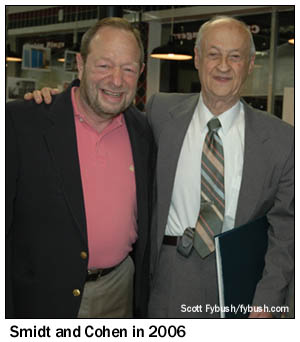 In Lowell, local
ownership continues at WCAP (980), as Maurice Cohen sells the
station after an amazing 56-year run, with Clark Smidt and Sam
Poulten leading the "Merrimack Valley Radio, LLC" group
that pays $2,660,000 for the station. In Lowell, local
ownership continues at WCAP (980), as Maurice Cohen sells the
station after an amazing 56-year run, with Clark Smidt and Sam
Poulten leading the "Merrimack Valley Radio, LLC" group
that pays $2,660,000 for the station.
Nassau and Entercom announce a deal, unconsummated at year's
end, that will have Entercom buying half of Nassau's WCRB (99.5
Lowell/Boston) for $10 million, and Entercom's WEEI sports programming
appearing on Nassau signals in Vermont, New Hampshire, Maine
and Cape Cod.
Saga picks up one of Citadel's Maine spinoffs, paying $3.5
million for WCLZ (98.9 Brunswick).
SEPTEMBER: Moses Znaimer adds a second Toronto radio
signal to his CFMZ, paying C$7,320,613 for the Caine family's
CHWO (740).
Donald Crawford Jr.'s DJR Broadcasting pays Crawford Sr.'s
Kimtron, Inc. $4.05 million for WPTR (96.7 Clifton Park NY) and
WDCD (1540 Albany NY). Bible Broadcasting Network pays $0 for
Citadel's WKRT (920 Cortland), which becomes WYBY.
Rae Roe sells CKJN (92.9 Haldimand-Norfolk ON) to Halliburton
Broadcasting.
OCTOBER: Oklahoma's KXOJ, Inc. sets up a $6.25 million
deal to buy WFRY (97.5 Watertown) and the rest of the Regent
Watertown cluster, as well as a $5.25 million deal for Tim Martz's
4 FM/1 AM cluster in the St. Lawrence Valley.
In Albany, Paul Vandenburgh departs WROW (590) and announces
plans to buy WTMM (1300 Rensselaer) from Regent for $850,000,
under the "Capital Broadcasting, Inc." banner. Regent
also sells Buffalo-market afterthought WECK (1230 Cheektowaga)
to Dick Greene's Culver Communications, for $1.3 million.
The never-ending soap opera that is WKPQ in Hornell continues,
as Gilles Leasing Services buys the studio and transmitter assets
of the station in a foreclosure sale - but not the license, which
remains with Bilbat Broadcasting for now.
In Connecticut, Gois Communications pays $2.65 million for
WLAT (910 New Britain) and WNEZ (1230 Manchester), from the bankrupt
Freedom Communications.
NOVEMBER: Nick Galli's 2510 Licenses LLC files to sell
oldies WCCL (101.7 Central City), "K-Love" contemporary
Christian WLKH (97.7 Somerset) and sports simulcast WBHV (1330
Somerset)/WPRR (1490 Johnstown) to Forever Broadcasting, for
$3 million.
DECEMBER: Chris DiPaola's Diponti Communications agrees
to pay $350,000 for WXNI (1230 Westerly), from the trustees of
Boston University. In Pennsylvania, Edward Niewinski's J.M.J.
Radio agrees to pay Holy Family Communications $100,000 for WQOR
(750 Olyphant).
In Quebec, Corus sells CHRC (800) to the Remparts de Quebec
hockey team for C$282,177.40.

The Year in Programming,
People and Calls
 JANUARY: The
year kicked off with a big bang in New York, as CBS chose "1/2/07"
as the launch date for a new format at WNEW (102.7), snuffing
"Mix 102.7" and the venerable WNEW calls in favor of
an adult contemporary sound called "Fresh" and new
calls WWFS. On Long Island, WBON (98.5 Westhampton) drops active
rock "Bone" for business talk as WBZB, under an LMA
that never leads to a completed sale. Islip's WLIE (540) flips
to Spanish religion under its new ownership. New York City rimshotter
WZAA (92.7 Garden City) drops its simulcast of "La Kalle"
WCAA (105.9 Newark NJ) for regional Mexican as "Que Buena,"
WQBU. JANUARY: The
year kicked off with a big bang in New York, as CBS chose "1/2/07"
as the launch date for a new format at WNEW (102.7), snuffing
"Mix 102.7" and the venerable WNEW calls in favor of
an adult contemporary sound called "Fresh" and new
calls WWFS. On Long Island, WBON (98.5 Westhampton) drops active
rock "Bone" for business talk as WBZB, under an LMA
that never leads to a completed sale. Islip's WLIE (540) flips
to Spanish religion under its new ownership. New York City rimshotter
WZAA (92.7 Garden City) drops its simulcast of "La Kalle"
WCAA (105.9 Newark NJ) for regional Mexican as "Que Buena,"
WQBU.
In Albany, female-oriented talk replaces sports on WTMM (1300
Rensselaer), renamed "Eve 1300" as WEEV. Down the road
in Syracuse, Beaner and Ken are out and Opie and Anthony are
in at WAQX (95.7 Manlius). In the Finger Lakes, WSFW (1110 Seneca
Falls) flips to visitor information.
In Erie, oldies "Froggy 94.7" WFGO becomes adult
hits "Bob," WXBB. The oldies move to WFNN (1330), which
briefly changes calls to WFGO, then changes back to WFNN. Across
town, WRIE (1260) drops standards for sports. Across the state
in Philadelphia, Tom Kelly's WHAT (1340) goes modern rock as
"Skin Radio," causing heads to be scratched across
the region.
In Boston, WRKO hires Tom Finneran to replace Scott Allen
Miller in mornings.
Closing out the month, Clear Channel drops another progressive
talker, as WAVZ (1300 New Haven CT) flips to ESPN sports.
A few call changes: WTMI (1290 West Hartford CT) returns to
its old WCCC calls. Up north, WCNM (1240 Lewiston ME) becomes
WEZR. In south Jersey, EMF flips WSJI (89.5 Cherry Hill) to WKJI
as it becomes a "K-Love" outlet.
Canadian changes: CHOK (1070 Sarnia ON) flips from oldies
to country.
Gone for good: WVZN (1580 Columbia PA), losing its tower site
and surrendering its license on January 11.
FEBRUARY: Ousted WRKO talker John DePetro returns to
his hometown, replacing Michigan import Dave Barber in midmornings
on WPRO (630 Providence).
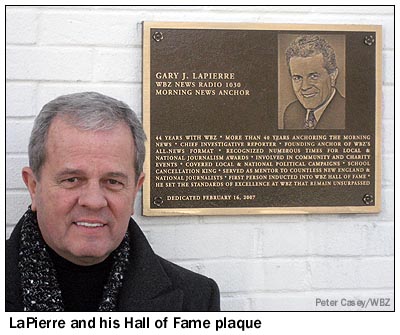 In Boston, retired
WBZ morning man Gary LaPierre is honored as the first inductee
into the "WBZ Radio Hall of Fame," along with a gala
retirement dinner. In Boston, retired
WBZ morning man Gary LaPierre is honored as the first inductee
into the "WBZ Radio Hall of Fame," along with a gala
retirement dinner.
Galaxy's exit from Albany brings an end to rocker "The
Bone," with WBOE (94.5 Ravena) becoming "K-Love"
WYKV and WOOB (93.7 Scotia) becoming "Air One" WYAI.
The Galaxy/EMF deal also brings "K-Love" to Syracuse,
replacing classic country on WSCP-FM (101.7 Pulaski), with WSCP
(1070 Sandy Creek) remaining with Galaxy as a simulcast of its
"TK99" (WTKW). New calls for WSCP-FM: WGKV.
Clear Channel exited the Kingston market, with Pamal flipping
new acquisition WBPM (92.9 Saugerties) from oldies to classic
hits.
New calls: WHQO (107.9 Skowhegan ME) becomes WFMX.
New to the air: WQRW (93.5 Wellsville NY).
MARCH: In western Massachusetts, Clear Channel shut
down the sports format at WNNZ (640 Westfield), replacing it
with public radio, in an LMA with WFCR (88.5 Amherst), which
in turn ended its LMA with WPNI (1430 Amherst), which in turn
flipped to a simulcast of Boston's WUMB.
 Progressive talk
WTWK (1070 Plattsburgh/Burlington) flipped to female-oriented
"Eve" talk. Elsewhere in upstate New York, WBRV (900
Boonville) dropped its FM country simulcast in favor of oldies. Progressive talk
WTWK (1070 Plattsburgh/Burlington) flipped to female-oriented
"Eve" talk. Elsewhere in upstate New York, WBRV (900
Boonville) dropped its FM country simulcast in favor of oldies.
In Connecticut, urban AC WKND returned to 1480 in Windsor,
swapping calls and formats with WNEZ (1230 Manchester), which
flipped to Spanish news-talk.
Two Maine religious signals swapped formats March 2, with
southern gospel "God's Country" moving from WMDR (1340
Augusta) to WMDR-FM (88.9 Oakland) and youth-oriented religious
"Zap" going the other way.
And in Philadelphia, KYW (1060) and WYSP (94.1) abandoned
their longtime Independence Mall home for new digs across the
street, with KYW-TV (Channel 3) and WPSG (Channel 57) moving
out to 15th and Spring Garden.
Call changes: CFMX (96.3 Toronto/103.1 Cobourg) to CFMZ, for
new owner Moses Znaimer.
Silent (temporarily): WEMR (1460 Tunkhannock PA), on March
8.
Back from a long silent period: WHWH (1350 Princeton NJ),
as well as WRMO (93.7 Milbridge ME).
New to the air: WTNN (97.5 Bristol VT), testing at month's
end and launching "Eagle Country" in early April.
APRIL: Pittsburgh gains a second FM talker April 2,
with the launch of talker "Zone" WTZN-FM on 93.7, formerly
"K-Rock" WKRZ, with John McIntire and Scott Paulsen
as anchor talents.
Over in eastern Pennsylvania, WYHM (1470 Allentown) returns
to its much earlier WSAN calls, dropping gospel for sports. Down
the road in Easton, WEST (1400) flips from oldies to Spanish
tropical "Hola," simulcasting WHOL (1600 Allentown).
And over at WSBG (93.5 Stroudsburg) morning man Gary Smith is
out after repeating Don Imus' unfortunate choice of words.
 New York's "Lite
106.7," WLTW, drops the "Lite" moniker, though
it would return before the year was out. New York's "Lite
106.7," WLTW, drops the "Lite" moniker, though
it would return before the year was out.
Scotty Hart's "Radio X" LPFM trimulcast (WLIX-LP
94.7 Ridge and several translators) flips from modern rock to
religion on Easter Sunday.
In New Jersey, WADB (1310 Asbury Park) flips from country
to ESPN Deportes, with sports talk in Spanish; WVNJ (1160 Oakland)
dumps the last of its standards to become "The Voice,"
talk and leased time.
On Cape Cod, Sandab swaps calls and formats between classic
rock "Rocket" WKPE (moving from 104.7 Orleans to lower-powered
103.9 South Yarmouth) and soft AC WOCN. In central Massachusetts,
WCRN (830) ramps up its profile, increasing power to 50,000 watts
at night, adding the Red Sox and hiring Hank Stolz from rival
WTAG.
Vermont's "Kiss 97.1" (WZRT Rutland) returns to
"Z97" under new owner Pamal.
In Montreal, CKAC (730) flips from talk to sports, still in
French. In Toronto, airport-information CFYZ (1280) becomes business-talk
CFBN. Down the road in Fort Erie, "Wild 101" CKEY becomes
"Z101," still targeting Buffalo listeners across the
river.
Call changes: WLGY (90.7 Nanty Glo PA) to WPKV, as it joins
EMF's "K-Love" family.
Off the air: WCFE (Channel 57/DTV 38) in Plattsburgh, as ice
felled its Lyon Mountain tower April 18. Another tower collapse,
on April 14, briefly silences WYBC (1340 New Haven CT).
New to the air: WSLP (93.3 Saranac Lake NY), on April 2; CIRR
("Proud FM 103.9") Toronto, April 16; CHGB ("97.7
the Beach") Wasaga Beach, Ontario.
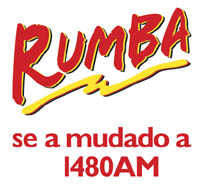 MAY:
The post-Imus chill costs another pair of shock talkers their
jobs, as Jeff "JV" Vandergrift and Dan "Elvis"
Lay lose their mid-morning slot on WFNY-FM (92.3 New York) and
other Free FM outlets. Two weeks later, CBS pulls the plug on
"Free FM" completely, flipping 92.3 back to "K-Rock"
WXRK on May 24, leaving only Opie & Anthony remaining from
the old format - and putting PD John Mainelli and hosts Nick
DePaolo and Leslie Gold out of work. MAY:
The post-Imus chill costs another pair of shock talkers their
jobs, as Jeff "JV" Vandergrift and Dan "Elvis"
Lay lose their mid-morning slot on WFNY-FM (92.3 New York) and
other Free FM outlets. Two weeks later, CBS pulls the plug on
"Free FM" completely, flipping 92.3 back to "K-Rock"
WXRK on May 24, leaving only Opie & Anthony remaining from
the old format - and putting PD John Mainelli and hosts Nick
DePaolo and Leslie Gold out of work.
Spanish-language FM bows out in Philadelphia, as Clear Channel
pulls the plug on "Rumba" WUBA (104.5), flipping the
FM to rock as "Radio 104.5" WRFF and moving "Rumba"
and the WUBA calls to former black gospel outlet WDAS (1480).
Nassau shuffles its Lehigh Valley FMs, moving soft AC "Lite"
from WWYY (107.1 Belvidere NJ) to WSBG (93.5 Stroudsburg PA)
and launching classic rock "Bone" on WWYY. Over in
Scranton, Entercom dumps soft AC "EZ 103.1" WFEZ (103.1
Avoca) in favor of a news-talk simulcast as WILK-FM.
Rochester rimshot WSNP (107.3 South Bristol) drops rhythmic
AC "Snap" for country as WCRR. Across the lake, "Lite
107" (CJTN-FM 107.1 Quinte West ON) gives way to classic
rock as "Rock 107."
In Connecticut, WXCT (990 Southington) flips from a talk LMA
to Spanish-language religion.
Call changes: WURP (1550 Braddock PA) to WLFP, WHUZ (94.3
Saegertown PA) to WUZZ.
New to the air: CJRS (1650 Montreal).
JUNE: Citadel's purchase of ABC Radio closes on the
11th, splitting WABC (770) and WPLJ (95.5) away from the ABC
television operations there, as well as WEPN (1050) and WQEW
(1560), which remain with Disney. The Citadel/ABC deal ends Citadel's
grandfathered market-cap status in Portland, where WCLZ (98.9
Brunswick) and WCYI (93.9 Lewiston) go into trust, with WCYI
becoming a temporary WCLZ simulcast.
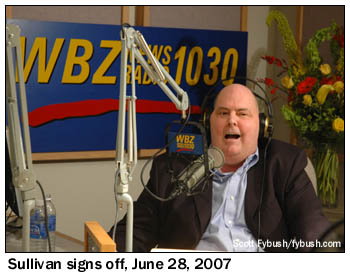 In
Boston, WGBH moves from its old Western Avenue digs to a state-of-the-art
studio complex overlooking the Mass Pike. In
Boston, WGBH moves from its old Western Avenue digs to a state-of-the-art
studio complex overlooking the Mass Pike.
Down the road, WBZ's ailing Paul Sullivan says goodbye to
his listeners in an emotional June 28 broadcast.
Another talk host signs off, too, as funding problems put
Chris Lydon's "Open Source" on hiatus.
In Philadelphia, WJJZ (97.5 Burlington NJ) completes its move-in
from Trenton, signing on from its new transmitter site in Wyndmoor
June 16.
Call changes: WTKU (1490 Pleasantville NJ) to WTAA, as it
flips from an oldies format to Air America talk; WJAN (95.1 Sunderland
VT) to WVTQ, as it flips from VPR's main network to its classical
service.
Silent: WALE (990 Greenville RI).
JULY: The big deal, of course, was the July 12 revival
of New York's WCBS-FM after two years of "Jack." Up
the Thruway in Albany, public broadcaster WMHT drops classical
from its second service, WBKK (97.7 Amsterdam), in favor of AAA
as "Exit 97.7," WEXT.
While oldies returned in New York, the "oldies"
name disappeared from WYNZ (100.9 Westbrook ME), as the Portland
signal re-imaged as "Big Hits Y100.9."
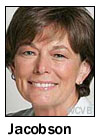 Natalie Jacobson's
abrupt retirement from WCVB (Channel 5) after more than 30 years
dominated Boston TV headlines, at least for the week between
her July 10 announcement and her July 18 farewell. Natalie Jacobson's
abrupt retirement from WCVB (Channel 5) after more than 30 years
dominated Boston TV headlines, at least for the week between
her July 10 announcement and her July 18 farewell.
In Hartford, WFSB (Channel 3) inaugurated its new studios
in Rocky Hill, bidding adieu to Broadcast House downtown after
almost half a century.
A few Canadian changes: CFMK (96.3 Kingston) dumps "Joe
FM" to go back to rock as "FM96," while CKNS (92.9
Haldimand-Norfolk) flips to "Jayne FM" hot AC as CKJN.
Call changes: Silent WCDJ (102.3 Truro MA) to WGTX, as it
prepares to return to the air with oldies. WKAP (1340 Reading)
back to WRAW.
New to the air: WXRG (99.1 Whitefield NH), as "Free 99.1,"
with an adult hits/variety format.
AUGUST: Costa/Eagle shuffles its format lineup August
1, moving Spanish talk "Impacto" WCEC from 1110 Salem
NH to 1490 Haverhill MA and English talk WHAV from 1490 to 1110.
Up in Maine, Allan Weiner's WREM (710 Monticello) moves to
780 under new calls WCXH, becoming part of the "Channel
X" AC simulcast with WCXX Madawaska/WCXU Caribou.
Vermont Public Radio brings its classical network to Burlington
Aug. 31, flipping Christian rock WAVX (90.9 Schuyler Falls NY)
to classical as WOXR.
Near Erie, WYNE (1530 North East) flips from a simulcast of
fine arts WMCE (88.5 Erie) to oldies. Near Scranton, WCDL (1440
Carbondale) flips to Spanish. In Philadelphia, WHAT (1340) ends
the month by dumping "Skin Radio" (still available
as a webcast) for standards "Martini Radio." In Selinsgrove,
WYGL (1240) flips from "Big Country" to sports.
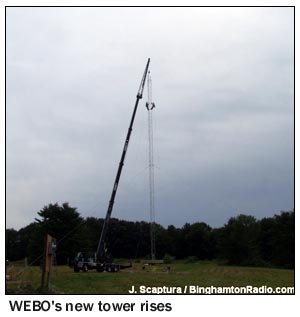 New towers rise
in Rochester, where WHIC (1460) finishes erecting its three-tower
array, and in Owego, where Dave Radigan's WEBO (1330) moves to
its new tower site. New towers rise
in Rochester, where WHIC (1460) finishes erecting its three-tower
array, and in Owego, where Dave Radigan's WEBO (1330) moves to
its new tower site.
New to the air: CHLN-FM (106.9 Trois-Rivieres QC), replacing
CHLN 550; CJRC-FM (104.7 Gatineau-Ottawa), replacing CJRC 1150;
CJDL (107.3 Tillsonburg ON), signing on Aug. 1 to supplement
daytimer CKOT (1510); CHLK (88.1 Perth ON), on Aug. 10; CKPT-FM
(99.3 Peterborough), replacing CKPT 1420 and displacing CKKK
99.5 to 90.5, on Aug. 20; CKYM (88.7 Napanee ON).
Back on the air: WGTX (ex-WCDJ) 102.3 Truro MA, as oldies
"Dunes 102."
Gone for good: WPEP (1570 Taunton MA), sacrificed mid-month
to allow WNSH (1570 Beverly) to raise power to 30 kW. Also gone
for good is the Greenstone Media talk network, sending WEEV (1300
Rensselaer/Albany) back to sports as WTMM on Aug. 17.
Call changes: WMBZ (88.5 Halifax PA) to WLVU, joining EMF's
"K-Love"; WDAH (91.5 Shenandoah PA) to WCIM, joining
Family Life Network.
SEPTEMBER: Former Providence mayor Vincent "Buddy"
Cianci, newly freed from federal custody, rejoins WPRO (630)
for mid-mornings, touching off a schedule shuffle that sends
Rush Limbaugh across town to WHJJ and moves John DePetro to morning
drive at WPRO.
"Free FM" comes to an end at Philadelphia's WYSP
(94.1) Sept. 13, with rock returning to the station and former
afternoon talker Kidd Chris moving to mornings a month later,
replacing Opie & Anthony. Erie's WFNN (1330) drops its nine-month
run with oldies, returning to sports Sept. 10. And in State College,
"Lite" WLTS (99.5 Centre Hall) gives way to adult hits
"Majic" WMAJ-FM on Sept. 17.
 With the collapse
of its deal to sell out to BusinessTalkRadio.net, the Morey Organization
shuffles programming at biz-talk WBZB (98.5 Westhampton), flipping
it to Spanish tropical as WBON, "La Fiesta." With the collapse
of its deal to sell out to BusinessTalkRadio.net, the Morey Organization
shuffles programming at biz-talk WBZB (98.5 Westhampton), flipping
it to Spanish tropical as WBON, "La Fiesta."
In New Jersey, WNNJ (1360 Newton) flips from oldies to standards.
Boston's WBZ names a permanent replacement for Paul Sullivan
a month after his death, naming Dan Rea as its new night talk
host, effective Oct. 1.
"Jayne FM" has a short run in Haldimand-Norfolk
ON, as the sale of CKJN (92.9) flips the station to "Moose
FM."
On TV, CanWest Global rebrands its "CH" network,
including Hamilton's CHCH (Channel 11) and Montreal's CJNT (Channel
62), as "E!," picking up the branding and some programming
from the US cable network.
Call changes: WKBR (1250 Manchester NH) to WGAM, WGAM (900
Nashua NH) to WGHM, WNTK (1010 Newport NH) back to WCNL (and
flipping to country the following month), WXBN (93.7 Lunenburg
VT) to WOTX.
Silent, temporarily: WLIS (1420 Old Saybrook CT), after a
Sept. 25 transmitter fire.
Back on the air: WEMR (1460 Tunkhannock PA).
New to the air: WHVL-LP (Channel 29) in State College PA,
with My Network TV and local sports; CHOP (102.7 Newmarket ON),
from Pickering College, Sept. 28.
Gone for good: WYPX (Channel 55) in Amsterdam NY, which surrendered
its analog license and went digital-only on channel 50 on Sept.
28.
 OCTOBER: CBS
Radio's campaign to undo all its programming gaffes of the last
few years continued on Oct. 5 with the return of top-40 "B94,"
replacing FM talk WTZN-FM (93.7 Pittsburgh) under eventual new
calls WBZW. OCTOBER: CBS
Radio's campaign to undo all its programming gaffes of the last
few years continued on Oct. 5 with the return of top-40 "B94,"
replacing FM talk WTZN-FM (93.7 Pittsburgh) under eventual new
calls WBZW.
Over on the TV dial, WPXI (Channel 11) relocates from Rising
Main Avenue to expensive new studios a few miles to the north,
with technical glitches galore for the first few days.
In Reading, WRAW (1340) returns to oldies from gospel, while
across the state, WOXX (99.3 Franklin)/WXXO (104.5 Cambridge
Springs) flip from top-40 "Kiss" to adult hits "Majic,"
with new calls WHMJ and WXMJ, respectively. In Altoona, WBRX
(94.7 Cresson) flips from classic rock "Q94" (still
on WBXQ 94.3 Patton) to AC "Mix 94.7." And in Scranton,
WNAK (730 Nanticoke) flips to Spanish, simulcasting WCDL (1440).
Hartford's WPHH (104.1 Waterbury) drops hip-hop "Power"
on Oct. 25, flipping to rock as "FM 104-one," with
new calls WURH following.
On Cape Cod, WKPE's classic rock on 103.9 is short-lived,
as the station flips to top 40 "Cape 104."
Poughkeepsie's WKIP (1450) flips from standards back to news-talk,
while Galaxy's rearrangement of the Utica dial takes hold with
the demise of rock on WRCK (107.3), which flips to EMF's "Air
1." EMF also puts its "K-Love" on WOKR (93.5 Remsen),
while Galaxy launches a sports trimulcast on WTLB (1310 Utica),
WIXT (1230 Little Falls) and WRNY (1350 Rome).
In the Upper Valley, WMXR (93.9 Woodstock VT) flips from rock
to talk as "the Pulse," while WVRR (101.7 Newport NH)
remains with rock, temporarily, as a move to Keene and 101.9
looms.
In Maine, WCYI (93.9 Lewiston) drops its temporary simulcast
of WCLZ (98.9 Brunswick) for an equally-temporary blues format.
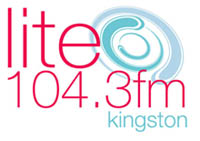 New to the air: CFFX-FM
(104.3 Peterborough ON), as "Lite 104.3," replacing
CFFX 960, Oct. 15. And WCWF (Channel 40) in Saranac Lake signs
on, with Pax/i Network programming. New to the air: CFFX-FM
(104.3 Peterborough ON), as "Lite 104.3," replacing
CFFX 960, Oct. 15. And WCWF (Channel 40) in Saranac Lake signs
on, with Pax/i Network programming.
Back on the air: WCFE (Channel 57) in Plattsburgh, where a
rush project to replace its downed tower pays off with an Oct.
4 sign-on from the new stick on Lyon Mountain, and WALE (990
Greenville RI), returning with Spanish AC.
Gone for good: WSJB (91.5 Standish ME), WTGP (88.1 Greenville
PA)
NOVEMBER: Citadel's impending hire of Don Imus moves
closer to reality, with eventual flagship WABC (770 New York)
sending morning co-host Ron Kuby packing.
On the FM dial, Whoopi Goldberg disappears from Philadelphia's
WISX (My 106.1) - and then, a month later, from New York flagship
WKTU (103.5). End-of-the-year budget cuts begin claiming prominent
jobs, including WLTW midday veteran Al Bernstein and Scranton
PD Jim Rising, as well as most of the airstaff at Entercom's
WLKK in Buffalo.
In Albany, Paul Vandenburgh's new talk format replaces sports
on WTMM (1300 Rensselaer) Nov. 26, while former WRKO morning
man Scott Allen Miller settles in at Vandenburgh's old job over
at WROW.
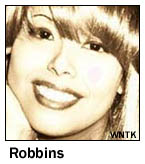 In the Upper Valley,
competitors join forces for an all-day radiothon to raise money
for breast cancer research, in honor of ailing DJ Pauline Robbins.
After 13 hours, the stations had raised over $37,000 for the
cause. In the Upper Valley,
competitors join forces for an all-day radiothon to raise money
for breast cancer research, in honor of ailing DJ Pauline Robbins.
After 13 hours, the stations had raised over $37,000 for the
cause.
In Fitchburg, WEIM (1280) adds evening and overnight Spanish-language
programming to its AC "Blend."
Call changes: WZXM (88.7 Middletown PA) to WXPH, and vice-versa
for 88.1 Harrisburg.
New to the air: CKGW (89.3 Chatham-Kent ON), Nov. 3 at 11
AM; CKXC (93.5 Kingston ON), taking the "Kix FM" country
format from WBDR (102.7 Cape Vincent NY); CKLC-FM (98.9 Kingston
ON), with a "classic alternative" format, replacing
CKLC 1380, Nov. 19.
Gone for good: CHUC (1450 Cobourg ON), signing off the AM
dial Nov. 7.
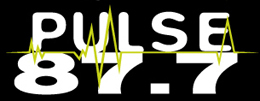 DECEMBER: Don
Imus returns - and so do Star and Buc Wild, late of WWPR, with
a surprise announcement that they'll be back on the air in January
via "WNYZ," a low-power TV station that's been using
its audio carrier as a pseudo-FM station at or about 87.7 on
the dial. It's been programming in Russian, but will soon emerge
as an English-language top-40 station called "Pulse 87.7." DECEMBER: Don
Imus returns - and so do Star and Buc Wild, late of WWPR, with
a surprise announcement that they'll be back on the air in January
via "WNYZ," a low-power TV station that's been using
its audio carrier as a pseudo-FM station at or about 87.7 on
the dial. It's been programming in Russian, but will soon emerge
as an English-language top-40 station called "Pulse 87.7."
Up in Westchester, Cumulus' WFAS-FM (103.9 Bronxville) sheds
several staffers, then applies to move its transmitter into the
Bronx, becoming a New York City signal.
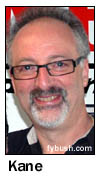 In Rochester, Entercom
closes on its purchase of CBS Radio's stations, relocating WCMF
(96.5) and WPXY (97.9) to its own High Falls studios and moving
WFKL (93.3) over to the former CBS studios to await eventual
sale along with WRMM (101.3) and WZNE (94.1). In the process,
several veteran CBS staffers lose their jobs, including WCMF's
Dave Kane and Dino Kay and WPXY's Pete Kennedy. In Rochester, Entercom
closes on its purchase of CBS Radio's stations, relocating WCMF
(96.5) and WPXY (97.9) to its own High Falls studios and moving
WFKL (93.3) over to the former CBS studios to await eventual
sale along with WRMM (101.3) and WZNE (94.1). In the process,
several veteran CBS staffers lose their jobs, including WCMF's
Dave Kane and Dino Kay and WPXY's Pete Kennedy.
In Utica, Imus' return to WXUR (92.7) kicks Bill Keeler out
of mornings after just a few weeks, sending his leased-time show
to afternoon drive. Up north, WBDB (92.7 Ogdensburg) flips from
top-40 to talk, becoming WQTK and picking up the lineup from
sister station WSLB (1400), which goes to sports.
A third TV newsroom returns to Burlington, as Fox affiliate
WFFF (Channel 44) launches a 10 PM newscast Dec. 3.
In Boston, WRKO shuffles mid-mornings, with Todd Feinburg
out and New York's Reese Hopkins in. In New Hampshire, Nassau
shuffles its Concord and Lakes Region lineups, replacing oldies
WNNH (99.1 Henniker)/WLKZ (104.9 Wolfeboro) with classic rock
"Frank." (Existing "Hawk" classic rockers
WWHK/WWHQ will go away in January to become WEEI relays.)
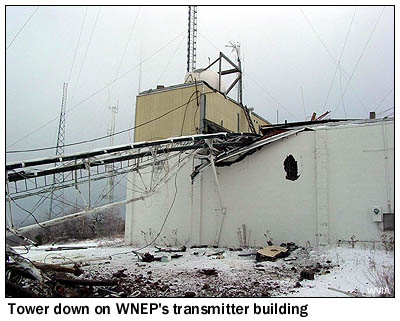 A transmitter-site
fire briefly silences WHP-TV and WRVV (97.3) in Harrisburg, followed
a week later by an ice storm that topples one tower and damages
several others on Penobscot Mountain near Scranton, taking WNEP
(Channel 16) and WVIA-DT (Channel 41) off the air. A transmitter-site
fire briefly silences WHP-TV and WRVV (97.3) in Harrisburg, followed
a week later by an ice storm that topples one tower and damages
several others on Penobscot Mountain near Scranton, taking WNEP
(Channel 16) and WVIA-DT (Channel 41) off the air.
In Philadelphia, anchor Alycia Lane spends the last few weeks
of the year off the air at KYW-TV after an altercation with a
New York police officer and some big tabloid headlines.
Year-end retirements include Philadelphia TV anchorman Marc
Howard, from KYW-TV, longtime WOR New York GM Bob Bruno, his
Hartford colleague Wayne Mulligan at WDRC, WDRC-FM morning man
John "Cadillac" Seville (replaced by former DRC jock
Jerry Kristafer), KDKA Pittsburgh's morning man Bob Kopler (replaced
by Pittsburgh native Bill Rehkopf), Binghamton morning jock Chris
O'Connor, Rogers radio head Gary Miles (replaced by former CHUM
Radio chief Paul Ski), and - involuntarily - WICC Bridgeport
morning man John LaBarca and WTVH Syracuse anchor Maureen Green.
(And on New Year's Eve, we learn that in New York, veteran WLTW
jock Valerie Smaldone is suddenly out of work, too.)
New to the air: CKEC-FM (94.1 New Glasgow NS), replacing CKEC
1320, at 9:41 AM Dec. 11.

Year-End Rant
In past years, we've had a tendency to ramble on with our
year-end thoughts. This year, we'll try to keep it short and
simple, expanding on some thoughts that we began putting together
in the last part of our 2006
Rant.
The theme then, as it has been so often in our Rants, was
the continued value of good local radio, and the possibility
that declining station values might actually allow more Radio
People - as opposed to private equity firms or publicly-traded
conglomerates - to buy radio stations and program them in interesting,
creative ways.
For the most part, that promise didn't come to pass in 2007;
even as station values remained flat or fell, the tremendous
crunch in credit made it all but impossible for anyone without
the deepest of pockets to get financing for station purchases.
And the rise of private equity made it a very bad year for many
Radio People, as companies looking to go private kept cutting
costs relentlessly, in large part by hacking away at big salaries.
There's no question that at many stations, the repeated rounds
of budget cuts in recent years has gone far beyond trimming the
fat that might have come with consolidation. As an industry,
we've gone through the muscle, deep into the bone, and it's no
exaggeration to say that more than a few once-great radio stations
(and even somewhat richer TV operations) are seeing their very
marrow get sucked out in the name of budget cuts. It's nothing
short of appalling to see a station as legendary (and lucrative)
as New York's WLTW losing an Al Bernstein, and those painful
cuts echoed at too many stations in 2007.
It's no wonder that the mood of many good Radio People turned
especially sour this year; there are simply too many highly talented,
extremely skilled jocks and newspeople and engineers and promotions
people and PDs out of work right now to make anyone comfortable
(including those still lucky enough to have jobs for the moment.)
What makes the repeated rounds of budget and job cuts all
the more frustrating is the instinctive knowledge that all Radio
People have: radio is, at its heart, a creative medium. It lives
and dies not on the basis of technology (witness the lack of
traction for HD Radio) but on the basis of creative content.
Other arms of the media world understand that good content
and creative people don't come for free. The movie industry gladly
pays tens of millions of dollars to its biggest stars, and generous
sums to its directors and other creative talents, too. The newspaper
industry has been through its own painful cutbacks, but is gradually
coming to the realization that it's really all about the content
it generates, not about the dead trees on which that content
was once printed - and as a result, at least some newspapers
are finding something of a renaissance as multimedia content
sources, generating text and audio and video that's distributed
through multiple channels. And at least for now, some of the
biggest generators of creative content - the writers of TV shows
and movies - are still fighting the good fight as they strike
for fair compensation for all the value they provide to the corporations
that employ them. The bleak landscape of the spring TV schedule
stands as evidence of the writers' value, and eventually the
networks and production companies will come around and pay up.
Yet much of the radio industry has spent the last decade or
so under the illusion that it can somehow survive on smoke and
mirrors, eliminating most of the creative talent that made it
great and doing little or nothing to encourage a new generation
of Radio People to come along and breathe new life into a medium
that's proven endlessly resilient over more than eight decades.
We've written often of the resurgence of radio in the fifties
and sixties in the face of new, game-changing competition from
TV. What made radio rise from its near-death experience then?
It was all about the content - the creative Radio People who
invented top 40 radio and talk radio and all-news radio and the
other new forms that moved the industry into its next golden
age.
That era has passed now, and there was a pervasive attitude
on the floor of the recent NAB Radio Show in Charlotte, a sense
among many top radio managers that they hoped to get just a few
more good years in before retiring. But if radio itself is to
have more than "a few more good years," the bleeding
has to stop, and soon. Somewhere out there, there are a few owners
who understand that an investment in quality content will pay
off handsomely down the road, but the industry and its leaders
need more of those visionaries.
Where are the station owners willing to take an FM HD2 subchannel
or two and let new young talents experiment with it? How many
small AM stations that are now forgotten, automation-driven afterthoughts
could be useful training grounds for the next Howard Stern or
Jean Shepherd or Scott Shannon, if only a few dollars were devoted
to making them "real" radio stations again? How many
of those people - and their talents - are being lost to other
fields because there's no room for them right now in radio? And
how long will radio try to fight those trends through regulation
(think of the expensive and ultimately fruitless battles the
NAB has fought against the satellite radio merger and against
LPFM), rather than fighting back by doing what it does best -
making great radio content?
In just about any market we can think of, there are enough
good Radio People out of work right now to completely staff an
entire station or three. Might 2008 be the year when some smart
owner puts together the budget that allows even a few of those
people to get back to doing what they do so well - and reaps
all the benefits that will come from creating a real radio station
that connects to its listeners in ways that an automation system
in a box never can?
We can only hope.
(We can also ask for your feedback - send it along at rant
at fybush dot com, and please let us know if it's OK to use your
name when we print a sampling of the responses in an upcoming
column.)
And as we do every year, we close out our Year in Review by
remembering the many great radio and TV people our region lost
in 2007.
In Memoriam
 DOMINGO CARBONELL,
Rochester Spanish-language broadcaster, 79 (Dec. 28, 2006) DOMINGO CARBONELL,
Rochester Spanish-language broadcaster, 79 (Dec. 28, 2006)
- ED SLUSARCZYK, founder of WADR Remsen NY, 84 (Dec. 29, 2006)
- JIM KARVELLAS, NY Knicks and Cosmos announcer, 71 (Jan. 1)
- ROB EILENBERG, former WRNY Rome DJ, 52 (Jan. 10)
- ROBERT K. ZIMMERMAN, Tele-Media founder, 73 (Jan. 15)
- PERCY SALTZMAN, pioneer Canadian TV meteorologist, 91 (Jan.
15)
- JOSEPH MAGNO, WAVM Maynard MA founder/advisor, 66 (Jan. 22)
- ART PALLAN, WWSW/KDKA Pittsburgh jock, 83 (Jan. 22)
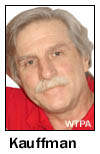 JOHN
MAJHOR, CHUM Toronto DJ and early VJ, 53 (Jan. 23) JOHN
MAJHOR, CHUM Toronto DJ and early VJ, 53 (Jan. 23)
- MICHAEL KOWAL, NJ engineer, 25 (Jan. 25)
- BOB TRACEY (BOB MICHEL), KDKA/WJAS Pittsburgh DJ, 83 (Jan.
26)
- BRONISLAW HUDELA, WKNY Kingston NY polka host, 88 (Jan. 29)
- KEVIN O'NEAL (RAYMOND FRAZIER), former WXTU Philadelphia
PD, 46 (Jan.)
- STEVE MILLER, WICZ Binghamton chief engineer, 54 (Feb. 4)
- CHARLIE LIESE, WCAX Burlington chief engineer, 84 (Feb. 4)
 BOB BUCHANAN, WBNG
Binghamton weatherman, 73 (Feb. 7) BOB BUCHANAN, WBNG
Binghamton weatherman, 73 (Feb. 7)
- JIM PAULSON, CHWO Toronto DJ, 67 (Feb. 14)
- RALPH PENZA, veteran WNBC New York reporter, 74 (Feb. 16)
- JIM SOMICH, Cleveland engineer and first WHTZ/Z100 CE, 65
(Feb. )
- KENNETH HUSBAND, WICU/WRIE Erie engineer, 80 (Feb. 20)
- JEFF "JAMMER" KAUFFMAN, WTPA Harrisburg morning
man, 57 (Mar. 2)
- RAYMOND "EL BOY" REYNOSO, WSKQ New York jock, 47
(Mar. 6)
- VICTOR PRYLES, WROR/WKLB Boston, 57 (Mar. 15)
- LYNDI STARR (MYERS), WQXA York, 23 (Mar. 20)
 DAVE ABBEY, WZKZ/WCLI
Corning, 54 (Mar. 23) DAVE ABBEY, WZKZ/WCLI
Corning, 54 (Mar. 23)
- JERRY GIRARD, WPIX sportscaster, 75 (Mar. 25)
- MELANIE APPLE WILLIAMS, WHP Harrisburg, 47 (April 2)
- DON METIVIER, WWSC/WCKM Glens Falls (April 6)
- BILL SHALLCROSS, WROW/WABY Albany, 78 (April 6)
- BARBARA ALLAN, WTIC/WTIC-TV meteorologist, 89 (April 11)
- RAY DILLEY, Vermont Public Radio founder, 67 (April 15)
- LEVITT JOSEPH "LEV" POPE, WPIX general manager,
83 (April 18)
- BERNARD SPIGNER, WALK Long Island, WCTC NJ, 51 (April 22)
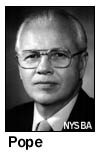 MILT GRANT, WGBS-TV,
WNYO-TV owner, 83 (April 28) MILT GRANT, WGBS-TV,
WNYO-TV owner, 83 (April 28)
- BILL TODD, "Johnny Williams" on WRKO, WIBG, WMID
(May 13)
- GUS SAUNDERS, "Yankee Kitchen" host, 85 (May 14)
- JIM HARRIOTT, WMCA, WNBC, WCBS, ABC anchor, 71 (May 14)
- BOB "SPARKY" SHERWIN, CKOC, CHML, CKNS morning
man, 52 (May 16)
- PETE WAMBACH, host of "This is Pennsylvania," 90
(May 17)
- OTTO MILLER, Principle Broadcasting principal (May)
- DUNCAN McARTHUR, GM3TNT, Fessenden anniversary commemorator,
64 (June 19)
- FRANK TOCE, WTKW Bridgeport NY founder, 72 (July)
- BOB SULLIVAN, WADK Newport RI news director, 57 (July 27)
- TOM SNYDER, NBC "Tomorrow" host and KYW/WNBC veteran,
71 (July 29)
 G. ROBERT WEIGAND,
WSPQ, WZKZ founder, 61 (Aug. 10) G. ROBERT WEIGAND,
WSPQ, WZKZ founder, 61 (Aug. 10)
- MERV GRIFFIN, entertainer and station owner, 82 (Aug. 12)
- PHIL RIZZUTO, Yankees Hall of Fame shortstop and veteran
announcer, 89 (Aug. 13)
- HAL PETERSON, WBSM New Bedford PD and talk host, 81 (Aug.
17)
- PAUL SULLIVAN, WBZ talk host, 50 (Sep. 9)
- GUY ACKLEY, WAEB Allentown veteran, 58 (Sep. 15)
- BILL GONILLO, WELI, News 12 sportscaster, 44 (Sep. 23)
- DAN PLANTS SR., tower climber, 51 (Sep. 24)
- DOUG PATTON, PA traffic reporter, 45 (Oct. 3)
- ED DAVIS, WFPG/WOND/WMGM-TV Atlantic City, 87 (Oct. 7)
- CRAIG KINGCAID, Rochester engineer (Oct. 28)
- HY LIT, Philadelphia radio legend, 73 (Nov. 10)
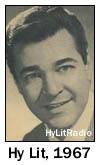 JD HOWARD, Long
Island DJ (Nov.) JD HOWARD, Long
Island DJ (Nov.)
- G.G. GRIGGS, WLFE St. Albans VT morning man (Nov. 13)
- KEITH RICH, veteran Toronto (and WNBC New York) DJ, 80 (Nov.
19)
- LARRY WACHTEL, WINS business reporter, 77 (Dec. 2)
- OLEEN EAGLE, WPCB Pittsburgh founder, 77 (Dec. 2)
- BOB "MacRAE" ZDROJEWSKI, veteran Buffalo DJ/PD,
58 (Dec. 4)
- FRED B. COLE, WBZ, WNAC, WHDH Boston, 92 (Dec. 6)
- SEAN DOHERTY, WDUQ Pittsburgh sports director, 47 (Dec. 8)
- PERRY WHITE, CHTD/CHSJ New Brunswick DJ, 43 (Dec. 10)
- DAVE SOVEREIGN, CJBQ, CJTN, CJLX Belleville, 69 (Dec. 15)
- STU NAHAN, WKBS Philadelphia, Flyers announcer, LA sports
anchor, 81 (Dec. 26)
NorthEast Radio Watch is made possible by the generous
contributions of our regular readers. If you enjoy NERW, please
click here to
learn how you can help make continued publication possible. NERW
is copyright
2008 by Scott Fybush. |

